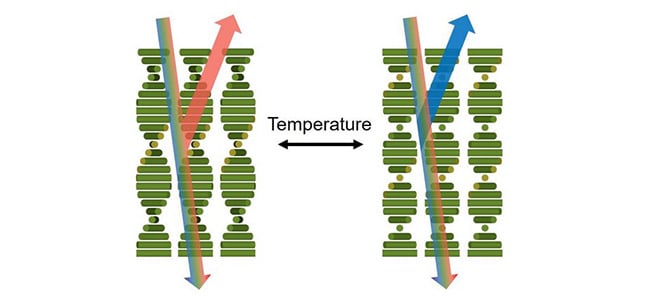
Smart Coatings Change Color with Temperature
EINDHOVEN, Netherlands, Sept. 15, 2021 — A team led by Eindhoven University of Technology (TU/e) Ph.D. student Weixin Zhang has developed organic photonic coatings that change colors with changing temperatures. The smart coatings can be easily processed and scaled up.
 Photonic materials have variable reflection properties depending on temperature. Weixin Zhang, from TU/e, has built upon existing research with cholesteric liquid crystals to develop coatings that change their color via temperature changes. The coatings have applications that span interactive artworks to smart windows. Courtesy of TU/e.
Photonic materials have variable reflection properties depending on temperature. Weixin Zhang, from TU/e, has built upon existing research with cholesteric liquid crystals to develop coatings that change their color via temperature changes. The coatings have applications that span interactive artworks to smart windows. Courtesy of TU/e.
The changing of color can influence our perception of objects, be used to warn us against dangers or hazards, and help to conserve energy. The coatings hold promise for a variety of applications that span heat regulating “smart” windows, temperature indicators and sensors, and even interactive artworks.
Zhang’s coatings are based on photonic materials, which have a periodic nanostructure that facilitates the reflection of specific wavelengths of light. As a result, the structure will appear to have the reflected color. Photonic materials hold multiple advantages over color-altering materials such as absorption-based dyes. First, the color exhibited by a photonic material can be precisely tuned by modifying the nanostructure of the material. This can be achieved with minimal changes to the chemical composition of the material itself, and it makes it easy to tune the color of the nanostructure over a wide range of wavelengths.
Second, given that the photonic materials only reflect light at specific wavelengths, it’s possible to produce materials that are transparent to visible light but will reflect longer wavelengths, such as infrared radiation.
Zhang, in previous research, used cholesteric liquid crystals, which display selective reflection properties that arise from their helical ordering, or form, and that self-assemble into photonic structures. In the earlier work, the team exploited the temperature response of cholesteric liquid crystals, comprising dynamic reflection color changes upon variation of temperature, via material systems of small mesogenic molecules; polymer-dispersed liquid crystals; and polymer-stabilized liquid crystals, or liquid-crystalline polymers.
Zhang took inspiration from the chameleon — which can change its skin colors to camouflage and regulate body temperature — to develop synthetic color-changing coatings that are responsive to different wavelengths. The first coating he developed is temperature responsive at visible wavelengths (between 400 and 700 nm), while the second is an infrared (between 700 and 2500 nm) reflective photonic coating.
The infrared coating could be used to regulate infrared light reflection in a window, which can in turn be used to help with indoor heat management. Using the organic photonic coating, this can be achieved without affecting the view through the window, given that the invisible structural colors selectively reflect infrared wavelengths.
Zhang fabricated a variety of adaptive temperature-responsive photonic coatings through the course of his research. He and his team additionally fabricated temperature-responsive cholesteric liquid crystals into other, different forms of photonic devices, including cells, free-standing films, and 3D objects via the easy processability and flexibility of the molecular design. For example, siloxane-based cholesteric liquid crystal polymers were synthesized and coated onto substrates using a simple film applicator. The resulting photonic films showed fast and fully reversible color responses to environmental temperature changes.
In a paper published in March, Zhang and his co-authors described prototype devices, including temperature indicators, IR-reflective smart windows, cold chain safety labels, actuators, and artistic decorations. Those materials have not yet been widely incorporated in commercial products, the authors said.
“Fabrication processes and overall performance are the remaining keys to product development,” the authors said.
The current research has been published in Advanced Photonics Research (
www.doi.org/10.1002/adpr.202100016).
Published: September 2021